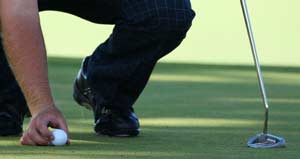The Hacker: With Mr Lebedev's help, I can prove I'm an old smoothie

Regular readers will be aware that as part of my new gameplan this year I am attempting to go for accuracy rather than distance by slowing down my swing. In order that I maintain the steady tempo essential to this task, I recite the name Alexander Cadogan under my breath during the course of the swing.
This was not a name chosen randomly. It came from a friend who received it as advice from an old professional in South Wales 40-odd years ago. Another friend said that he had been given the same name by the pro at Redditch Golf Club around the same time.
Mr Cadogan, who was one of our top civil servants during the war and our representative at the United Nations from 1946-50, was not only a man of impeccable breeding and reliability but appealed to the pros as intonationally perfect as a swing regulator.
Alas, although he has done sterling service thus far, I am going to have to dispense with his services.
From this weekend I am changing the name I use to Alexander Lebedev. Some may see a trace of obsequiousness in this, but early trials have indicated that his name has precisely the sort of rhythm my swing is looking for.
And this visionary gentleman will go straight into action in the March medal, which represents the biggest challenge yet to my new plan.
My entire being is concentrated on breaking 100 in a medal, and this is the first of the season. It will not be easy, because the wet weather is by no means conducive to low scoring. There's no run on the ball, and since we will be playing from the back tees for the first time in five months, the temptation to hit the hell out of the ball will be difficult to resist.
It is more important than ever to maintain a steady and deliberate swing and plot a straight if unspectacular path around the course. Unfortunately, my last game was not ideal preparation for my new tactical approach. It was a Texas Scramble, in which a team of four each plays a shot, selects the best shot and each takes the next shot from that spot. It means that even the worst player, usually me, gets chances to putt for birdies, but there is a sizeable snag.
The callous way our club play it, each member of the team must have at least four of his tee shots chosen. You can't rely on taking the best player's drive all the time.
For high-handicappers this can lead to anxious times, and mutterings from their team-mates if they have not fulfilled their quotas with only a few holes left.
There are many instances of a team having to take a tee shot no matter where it has been hit.
Thankfully, I had three of my drives chosen before we reached the ninth. I was playing with Ross, off six, who hit the ball a mile, Phil, off 13, another big hitter, and Alex, off 22, who had trouble off the tee but hit the most colossal fairway shots.
Had we been better on the greens we would have been contenders, but as it turned out we were five shots shy of the winners.
Since I had spent the day trying to contribute to the team effort by hitting the ball as far as I could, my tempo was back in the bad old days.
But I'm backing me and Mr Lebedev to prove how smooth I can really be.
Tip of the week
No 44: reading the breaks
Once you have mastered pace with your putts, to achieve good accuracy, you must be able to read the breaks well. Most greens in the UK run fairly slowly apart from three or four months of the year. The slower the green, the harder the ball must be struck, and at speed the ball will not take much borrow across the putting surface.
My first and most important piece of advice is "don't read too much into it". If you are looking for a break, there more than likely isn't one. Secondly, look at the entire aspect of the green, not just your line of putt. Get a feel of what the whole green is doing, as this will often have an overriding impact on the putt.
Finally, look at the angle of the hole. Look at whether the right or left lip is higher or lower as this can help to decide which way the ball will die into the hole.
Simon Iliffe, Head Professional, Purley Downs GC, Surrey. www.theshortgame.co.uk
Subscribe to Independent Premium to bookmark this article
Want to bookmark your favourite articles and stories to read or reference later? Start your Independent Premium subscription today.

Join our commenting forum
Join thought-provoking conversations, follow other Independent readers and see their replies